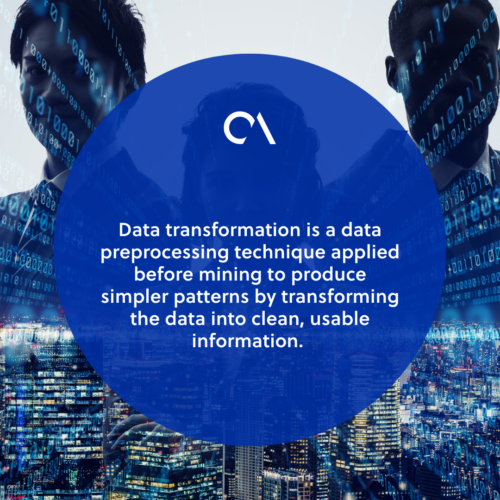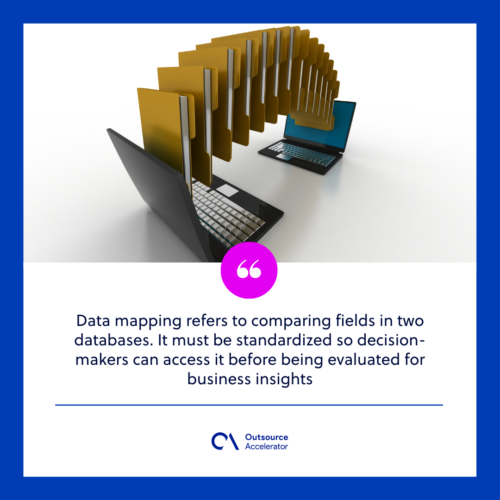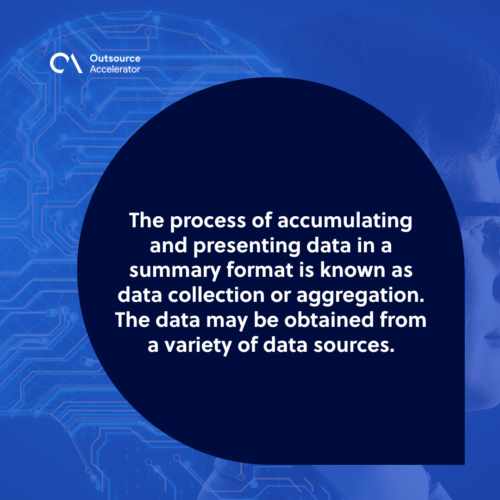Data transformation techniques to turn basic data into beneficial knowledge

Many companies find organizing, processing, and organizing data daunting. But with the correct understanding of data transformation techniques, it is possible to implement a data-driven culture in your company.
Developing a long-term strategy for analysis and transformation is essential. It can often be challenging to track or comprehend raw data, so most of the time, it needs to be preprocessed before any information can be extracted from it.
Effective data transformation techniques should be considered to change the data into the right form and make it useful.
What is data transformation?
Data transformation is a data preprocessing technique applied before mining to produce simpler patterns by transforming the data into clean, usable information. It is changing data from a source to a destination format.
This can involve transforming data types, removing nulls and duplicates, collecting data, enriching it, or doing other changes to clean it up.
Data transformation can also be defined as modifying data characteristics for better access or storage. Data’s format, structure, or values may all transform. The transformed information might be simpler for both people and machines, giving your system a better-organized form.
Applying efficient data transformation techniques in business processes improves the effectiveness of analytical procedures and makes it possible to make judgments using data.
By getting insights into crucial operational and informational internal and external processes, organizations gain from adopting effective data transformation techniques.

The data transformation process
Data transformation can improve business and analytical processes’ effectiveness and improve data-driven decision-making. The first phase of data transformation should include data type conversion and flattening of succeeding data.
Each processing layer must be built to carry out a distinct set of operations that satisfy a recognized technical or commercial requirement.
Here’s a glimpse of how the data transformation process usually takes place:
Data discovery
Data analysts spend the first stage understanding and locating relevant raw data. Analysts and developers can better understand the necessary conversions by profiling the data.
Data discovery starts with information extraction from a data source, and then the data is copied to its destination. The first transformations concentrate on modifying the format and structure to guarantee that the data is compatible with the destination system and its previous format.
Data mapping
Data mapping refers to comparing fields in two databases. Data must be standardized so decision-makers can access it before being evaluated for business insights.
In this stage, analysts choose the methods for modifying, matching, filtering, joining, and aggregating distinct fields.
The mapping and translation of data are two of the most straightforward data transformations. Data is translated from one system’s format to another system’s format by means of translation.

Data extraction
The process of gathering or extracting various forms of data from many sources, many of which may be erratically organized or entirely unstructured, is known as data extraction. Data extraction enables the consolidation, processing, and refinement of data to be kept in a single location and later altered. These areas could be on-site, in the cloud, or a combination of the two.
During this phase, data is transferred from a source system to a target system. Both structured and unstructured sources may be used in the extraction process.
Code generation and execution
The raw data must be transformed once extracted and imported to be stored in a manner suitable for business intelligence and analytical use. This code is run daily or hourly to deliver accurate and timely analytical results.
Review
Code must be reviewed and checked after implementation to ensure it was done correctly. This process involves removing empty fields, columns, and records.
This includes renaming schemas, tables, and columns for clarity and casting and converting data types for compatibility.
Sending
Sending data to a data warehouse or other structured locations completes the process.
Six data transformation strategies to convert data
Before analysis or storage in a data warehouse, there are several data transformation techniques that can help structure and clean up the data.
Here are some data transformation techniques you can use to turn basic data into beneficial knowledge:
Data smoothing
Using some algorithms, the process of data smoothing is used to remove noise from the dataset. It makes it possible to draw attention to crucial dataset features. It aids in pattern prediction.
The idea behind data smoothing is that it can recognize small changes to assist in predicting various trends and patterns. This aids analysts and traders in spotting data patterns they might not notice at first glance.
Attribute construction
From the provided attributes, new attributes are made and used to aid the mining process. The original data is simplified in this stage, making the mining more efficient.
With this technique, we simply turn the existing data into a more understandable and appealing format without altering or adding any new data.
Data aggregation
The process of accumulating and presenting data in a summary format is known as data collection or aggregation. The data may be obtained from a variety of data sources.
The quantity and quality of the data used significantly impact how accurate the insights from data analysis are.
Everything from decisions about product pricing, operations, and marketing strategies to financing and business strategy can benefit from data aggregation.

Data normalization
When data are “normalized,” their values are scaled to a much smaller range, such as [-1, 1] or [0.0, 1.0]. There are various techniques for normalizing the data.
Min-max normalization
The original data is transformed linearly using this technique.
Z-score normalization
With this technique, the mean and standard deviation are used to normalize the value for attribute A.
Decimal Scaling
Decimal scaling normalizes the value of attribute A by moving the decimal point in the value.
Data discretization
Data discretization is a technique for breaking down a large number of data values into smaller ones, making it simpler to manage and evaluate data. In other words, data discretization helps turn continuous data’s attribute values into a finite collection of intervals.
This procedure divides continuous data into a collection of data intervals. Small interval labels replace continuous attribute values. This facilitates studying and analyzing the data.
Data discretization can be divided into two categories: supervised discretization, which uses class information, and unsupervised discretization, which depends on whether the process moves in the top-down or bottom-up direction, or both.
Data generalization
Data generalization involves broadening the categories in which data is categorized in a database to produce a more comprehensive picture of the trends or insights it offers.
Data generalization is necessary to evaluate the data you’ve gathered and protect the privacy of the people included in that data. It’s an effective technique for removing personally identifiable information while keeping the value of the data points.
Using concept hierarchy, data generalization elevates low-level data attributes to high-level data attributes. It is helpful to convert from a lower to a higher conceptual level to see data more clearly.
There are two methods of data generalization, namely, the data cube process (OLAP) approach and the attribute-oriented induction (AOI) approach.
What do we gain from data transformation?
Data is transformed to improve its organization so it can be simpler for people and machines. Improved data quality and protection from potential landmines are benefits of adequately formatted and validated data from implementing effective data transformation techniques.
Data transformation makes the compatibility of applications, systems, and data types possible. It might be necessary to transform data differently if used for different purposes.
Following efficient data transformation techniques can assist your company in getting rid of inconsistent data and other quality problems like missing values. Transformed data is then stored and standardized in a source location, making it quick and simple to retrieve.
Businesses are continually producing various data from a growing number of sources. It can be difficult to organize and comprehend metadata if inconsistencies exist. Your metadata is refined during data transformation, making it simpler to manage and understand.
Although businesses may constantly collect data, much of it needs to be analyzed. By standardizing and improving the usability of your data, the transformation makes it simpler to get the most out of it.
Businesses must monitor the accuracy of their data since it informs important decisions. If some data contains inaccuracies, you may overlook crucial information that underpins effective outcomes. You can eliminate these kinds of issues and complete any gaps in the data through data transformation techniques.







 Independent
Independent




